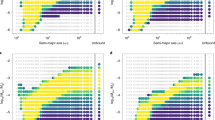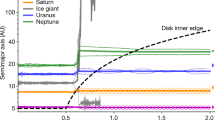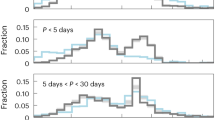Abstract
Recent observations of the planet HD209458b indicate that it is surrounded by an expanded atmosphere of atomic hydrogen that is escaping hydrodynamically1,2,3. Theoretically, it has been shown that such escape is possible at least inside an orbit of 0.1 au (refs 4 and 5), and also that H3+ ions play a crucial role in cooling the upper atmosphere5,6. Jupiter’s atmosphere is stable7, so somewhere between 5 and 0.1 au there must be a crossover between stability and instability. Here we show that there is a sharp breakdown in atmospheric stability between 0.14 and 0.16 au for a Jupiter-like planet orbiting a solar-type star. These results are in contrast to earlier modelling4,8 that implied much higher thermospheric temperatures and more significant evaporation farther from the star. (We use a three-dimensional, time-dependent coupled thermosphere–ionosphere model6 and properly include cooling by H3+ ions, allowing us to model globally the redistribution of heat and changes in molecular composition.) Between 0.2 and 0.16 au cooling by H3+ ions balances heating by the star, but inside 0.16 au molecular hydrogen dissociates thermally, suppressing the formation of H3+ and effectively shutting down that mode of cooling.
This is a preview of subscription content, access via your institution
Access options
Subscribe to this journal
Receive 51 print issues and online access
$199.00 per year
only $3.90 per issue
Buy this article
- Purchase on Springer Link
- Instant access to full article PDF
Prices may be subject to local taxes which are calculated during checkout



Similar content being viewed by others
References
Vidal-Madjar, A. et al. An extended upper atmosphere around the extrasolar planet HD209458b. Nature 422, 143–146 (2003)
Vidal-Madjar, A. et al. Detection of oxygen and carbon in the hydrodynamically escaping atmosphere of the extrasolar planet HD209458b. Astrophys. J. 604, L69–L72 (2004)
Ballester, G., King, D. K. & Herbert, F. The signature of hot hydrogen in the atmosphere of the extrasolar planet HD 209458b. Nature 445, 511–514 (2007)
Lammer, H. et al. Atmospheric loss of exoplanets resulting from stellar X-ray and extreme-ultraviolet heating. Astrophys. J. 598, L121–L124 (2003)
Yelle, R. V. Aeronomy of extra-solar giant planets at small orbital distances. Icarus 170, 167–179 (2004)
Koskinen, T. T., Aylward, A. D., Smith, C. G. A. & Miller, S. A thermospheric circulation model for extrasolar giant planets. Astrophys. J. 661, 515–526 (2007)
Strobel, D. F. in Atmospheres in the Solar System, Comparative Aeronomy (eds Mendillo, M., Nagy, A. & Waite, J. H.) 7–22 (AGU, Washington DC, 2002)
Lecavelier des Etangs, A. A diagram to determine the evaporation status of extrasolar planets. Astron. Astrophys. 461, 1185–1193 (2007)
Miller, S. et al. H3 +: the driver of giant planet atmospheres. Phil. Trans. R. Soc. A 364, 3121–3137 (2006)
Neale, L., Miller, S. & Tennyson, J. Spectroscopic properties of the H3 + molecule: a new calculated line list. Astrophys. J. 464, 516–520 (1996)
Hunten, D. M. The escape of light gases from planetary atmospheres. J. Atmos. Sci. 30, 1481–1494 (1973)
Ribas, I., Guinan, E. F., Gudel, M. & Audard, M. Evolution of the solar activity over time and effects on planetary atmospheres. I. High-energy irradiances (1–1700 Å). Astrophys. J. 622, 680–694 (2005)
Baraffe, I. et al. The effect of evaporation on the evolution of close-in giant planets. Astron. Astrophys. 419, L13–L16 (2004)
Rice, W. K. M. & Armitage, P. J. Quantifying orbital migration from exoplanet statistics and host metallicities. Astrophys. J. 630, 1107–1113 (2005)
Tian, F., Toon, O. B., Pavlov, A. A. & De Sterck, H. Transonic hydrodynamic escape of hydrogen from extrasolar planetary atmospheres. Astrophys. J. 621, 1049–1060 (2005)
Shkolnik, E. E., Gaidos, E. & Moskovitz, N. No detectable H3 + emission from the atmospheres of hot Jupiters. Astron. J. 132, 1267–1274 (2006)
Acknowledgements
T.T.K. has been supported by UCL and Perren studentships and A.D.A and S.M. have been supported by the Science and Technology Facilities Council (STFC). This work was partly carried out on the Keter High Performance Computer System, which is managed by the Miracle Astrophysics Project and funded by STFC. SOLAR2000 Research Grade v2.23 irradiances are provided by Space Environment Technologies. We also thank R. Nelson and M. Fogg for advice on giant planet migration rates and N. Achilleos for assistance with global plots.
Author Contributions T.T.K. developed the thermospheric circulation model for extrasolar giant planets based on existing models of gas giants in the Solar System. T.T.K, A.D.A and S.M. directed and carried out the modelling. S.M. calculated the non-LTE emission rates for H3+.
Author information
Authors and Affiliations
Corresponding author
Supplementary information
Supplementary Information
The file contains Supplementary Methods, Supplementary Table 1 with Legend and additional references. The details of the model are discussed in Supplementary Methods. In that section the basic features of the neutral thermosphere and ionosphere in our coupled global circulation model are explained. Supplementary Table 1 shows the photochemical reactions that are included in the model and that are similar to those occurring in Jupiter’s upper atmosphere. Supplementary Notes include all the references that are referred to in either Supplementary Methods or Supplementary Table 1. (PDF 102 kb)
Rights and permissions
About this article
Cite this article
Koskinen, T., Aylward, A. & Miller, S. A stability limit for the atmospheres of giant extrasolar planets. Nature 450, 845–848 (2007). https://doi.org/10.1038/nature06378
Received:
Accepted:
Issue Date:
DOI: https://doi.org/10.1038/nature06378
Comments
By submitting a comment you agree to abide by our Terms and Community Guidelines. If you find something abusive or that does not comply with our terms or guidelines please flag it as inappropriate.



